Many potential buyers are concerned about the question: does the dishwasher save water, how much water does it spend? Still, the main advantage of the dishwasher is the opportunity to save personal time, which the owner or hostess can use at their own discretion, and not engage in tedious daily monotonous work.
Product Use
Of course, for bachelors, buying a miracle of equipment may not be such an urgent issue, because there are a lot of tips on the Internet, right up to putting a disposable plastic bag on a plate. But for at least a small family, the acquisition of such a product is a real way out. In addition, a modern dishwasher can significantly save money on the use of water resources.

Consumption
And what is the approximate consumption of a dishwasher? Of course, it will differ slightly, depending on the brand, model and year of release. But even outdated dishwasher samples are unlikely to consume more than 20 liters of water. Almost all manufacturers indicate in the technical characteristics of the product the main parameters of water consumption by washing equipment. It is divided into full-size and narrow, depending on the size. These purchase criteria show how much dishes a particular machine can accommodate, and how many items it can wash in a high-quality manner in one wash.
13 - 14 ordinary sets of dishes can bring to shine a full-sized product. The maximum water consumption in this case does not exceed 15 liters. Machines of compact size (narrow) capable of processing from 6 to 9 sets. In this case, the equipment will take no more than 10 liters of water from the water supply system.
Saving
But does the dishwasher save our water? According to experiments and consumer reviews, when manually washing dishes in an amount corresponding to 1 loading of a dishwasher, the consumption of hot water reaches about 70 l, and the cold spends about 30. It turns out that modern household washing equipment can significantly reduce the meter reading of water supply networks.
So how much water does the dishwasher spend? Here is an example:
- Bosch SPV63M50 (compact) - loading up to 9 sets, consumption 8 l;
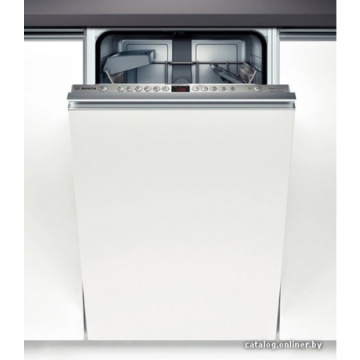
- Siemens SN66M094 (normal) - loading up to 14 sets, consumption 10 l;
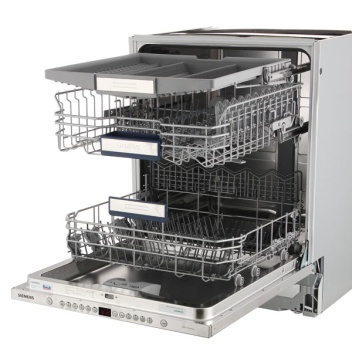
- Smeg BLV2VE (full-size) - 13 rooms, 8.5 liters.
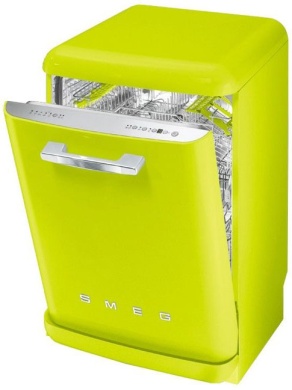
For a small family and senior citizens, the compact model is quite enough, otherwise you will have to spend the excess water on washing just a few plates and save will not work. Or, as an option, a long accumulation of dishes for a full load of the machine. The leaders in terms of savings at this stage are European brands. It is these machines that should be preferred if the factor of saving water resources is significant for the consumer. Such well-known brands as Electrolux, Bosch, Siemens, pay special attention not only to saving tap water, but also electricity.
The models presented in the example relate to premium products. Average power consumption in the range of 0.7 to 0.9 kW, depending on the size of the equipment. Many modern models have a half load function, its use allows you to save up to 30% of water. The undisputed leader, according to consumer reviews, constantly leading the list of the best dishwashers, is Bosch.
Washing details
Many consumers wonder why there is significant water savings when using a dishwasher. The main reason is that modern appliances use special technology in the process of washing kitchen utensils. The volume of water already collected from the water supply system is used by the dishwasher several times. The liquid solves the following tasks:
- It is applied to preliminary spraying.
- Wash with special detergents.
- Rinse.
Having completed one operation, the clever technique does not discharge water into the sewer, but passes it through filters and uses it in the next production cycle. During the washing of dirty dishes, a partial discharge of liquid occurs, and a fresh portion of water comes from the water supply. Thin water streams under high pressure are ejected from the sprayers, which also contributes to significant water savings.
On average, a full cycle of washing and drying kitchen utensils lasts about 2 hours. But if you take into account that a decent amount of dishes are washed with this water consumption, moreover, when using 4 - 5 sets, you can wash several pots and pans, which is also a significant plus. An experienced hostess can cope with such a volume in just 30 minutes. On the other hand, even rest our time is worth a lot. However, some time you still have to spend on cleaning dirty dishes from solid or adhering food debris. But in comparison with a manual sink - it is insignificant.
Payback technology
Bearing in mind the factor of significant water overrun during manual washing, it makes sense to pay attention to the payback time of the kitchen assistant. According to most sources, the average payback for dishwashers is about 4 years, and at night 3.5 (by the way, a good way to save electricity). Given that modern manufacturers of household appliances declare a minimum resource for the use of such equipment at the level of 5 years, the benefit is obvious. Moreover, in view of the competition and the increasing spread of online stores, you can choose the necessary model cheaper or at a discount.
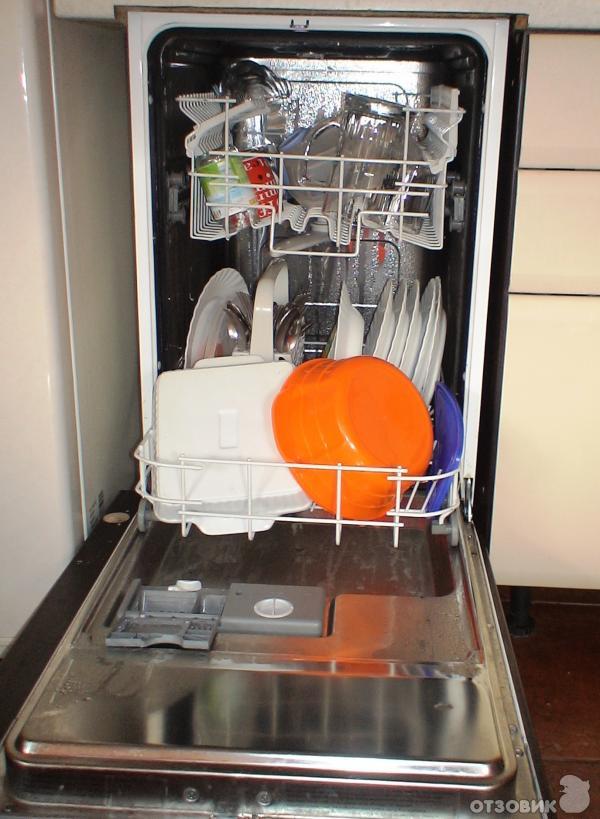
Some nuances
When washing dishes, the kitchen appliance allows for fairly high temperatures up to 75 - 90aboutC. This allows you to achieve sterility of the dishes, which is important when the family has small children.
Large-sized dishwashers have an optimal ratio of performance and profitability in relation to the volume of dishes. Such models should give preference to large families.
For those regions that have to put up with water hardness, air conditioning is almost the only way to clean glassware and get rid of stains after drying.
Read also: How to determine and set the hardness of water in a dishwasher?
Deficiencies
Such useful equipment as a dishwasher is not without drawbacks:
- In the case of an erroneous purchase of a kitchen product without taking into account dimensions, such a technique is often used as a storage room for unwashed dishes, which entails the appearance of not quite pleasant aromas.
- The dishwasher itself periodically needs to be cleaned and washed. Sometimes it is necessary to start idle cycles, as a result of which self-cleaning occurs. Filters and a pump also require cleaning.
A couple of tips
The function of equipment of the “half-filled” type does not mean at all that in this case, the use of this kitchen equipment with water and electricity will be at an optimal level. In most cases, the water consumption of the dishwasher is 60% of the normal amount. The same situation with electricity, in addition, too dirty dishes may simply not be washed.
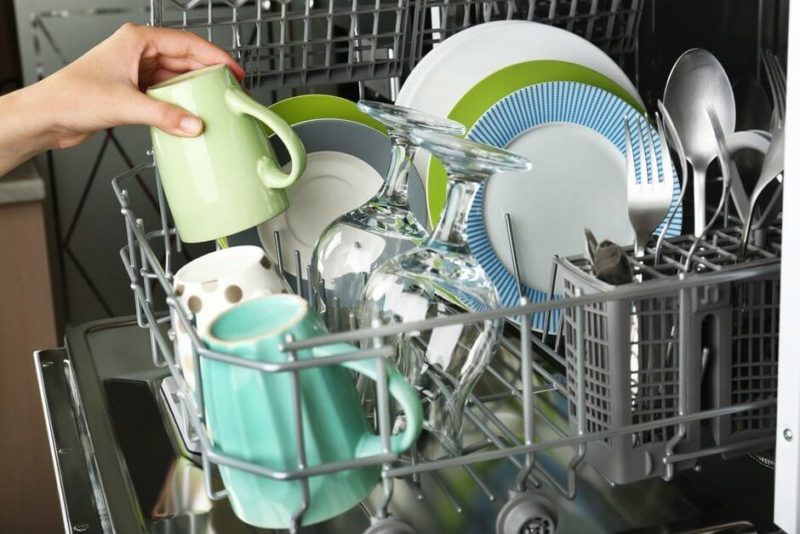
Systematic and reasonable laying of dishes will maximize the filling of the dishwasher. This will provide an opportunity not only to save water and electricity, but also provide perfectly clean dishes at the exit.Typically, any product comes with instructions with detailed pictures and recommendations on how to lay kitchen utensils.
It should be borne in mind that a volumetric dishwasher is more profitable, based on the calculation of water consumption per one full load. But she will use water according to the program, regardless of the amount of dirty dishes.
Water saving and other benefits
In addition to significant water savings, modern dishwashers have a lot of other advantages. Firstly, the quality of washing the dishwasher is incomparable with the manual way of exposure to dirty dishes. This is affected by special detergents, as well as the high temperature of the water. After all, an ordinary person will not wash the dishes at 75 degrees in a liquid medium. Secondly, it is estimated that a dishwasher saves the owner time for a year comparable to the employee’s monthly presence at work.
Such kitchen equipment can be successfully used not only for washing dishes. All kinds of gas burners, barbecue grills and even refrigerator shelves, many owners of modern appliances manage to wash in the dishwasher. And only our people could think of effectively using dishwashers to wash potatoes and other vegetables, even rubber boots are used.
Total
The dishwasher significantly saves water resources, and, as a result, a significant decrease in the counter and a reduction in water charges. This product can be used not only for its intended purpose. Dishwasher in the house - saving time and money, comfortable condition of all households.



